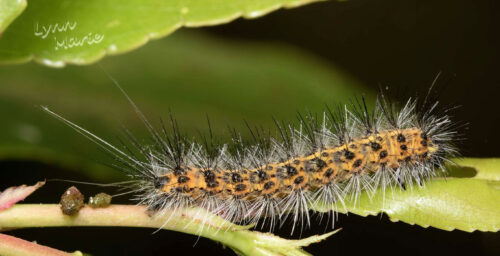The saltmarsh caterpillar (Estigmene acrea) (Drury) is a native insect found throughout the United States. It is common in the southern United States as a pest. Adults are large moths; wingspan can measure 3.5 to 4.5 cm and are very distinct. The wings are mostly white in color; there are generally many small, irregular black spots. The male hind wings are yellow, the underside may also have a yellow tint, and the female is white. The abdominal segments are yellow with a series of large black spots dorsally.
Females generally live only four to five days; however, they can produce more than one cluster of eggs. She can produce 400 to 1000 eggs in one or more clusters. Eggs are tiny and spherical; they are initially yellow and soon turn gray in color. Eggs will hatch in four to five days. There are five to seven instars.
Larvae are active dispersers, a behavior not typical among caterpillars. Late instar larvae will move over the soil searching for food and can be found individually or in groups. Caterpillars damage crops, mostly during fall. With each succeeding instar consumption of plants doubles. When pupation occurs, they are on the soil among leaf debris. When pupation is complete, it is dark brown, measuring 30 mm, and lasts about 12 to 14 days.
Broadleaf weeds are the initial host plants for this species, though larvae will commonly disperse late in the growing season to damage vegetable and field crops. The favored weed host are usually pigweed (Amaranthus spp.); however, many others can be consumed, such as anglepod (Gonolobus spp.).; sicklepod (Cassia tora); dog fennel (Eupatorium capillifolium); ground cherry (Physalis spp.); and mallow, (Anoda spp.).
Agricultural management commonly used insecticides on saltmarsh caterpillars. Baits are not an effective method to manage the species. Physical barriers can be used such as ditches or trenches with steep sides to prevent the invasion of crops.
Cool Fact! Saltmarsh caterpillar’s name is derived from being a pest of Saltgrass hay grown around Boston. Though ironically, grasses are not a preferred host plant.

